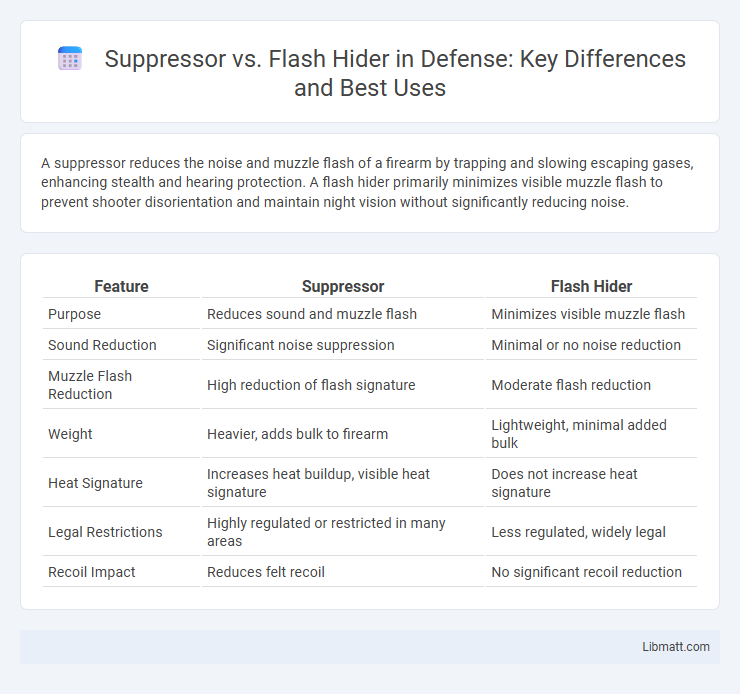A suppressor reduces the noise and muzzle flash of a firearm by trapping and slowing escaping gases, enhancing stealth and hearing protection. A flash hider primarily minimizes visible muzzle flash to prevent shooter disorientation and maintain night vision without significantly reducing noise.
Table of Comparison
| Feature | Suppressor | Flash Hider |
|---|---|---|
| Purpose | Reduces sound and muzzle flash | Minimizes visible muzzle flash |
| Sound Reduction | Significant noise suppression | Minimal or no noise reduction |
| Muzzle Flash Reduction | High reduction of flash signature | Moderate flash reduction |
| Weight | Heavier, adds bulk to firearm | Lightweight, minimal added bulk |
| Heat Signature | Increases heat buildup, visible heat signature | Does not increase heat signature |
| Legal Restrictions | Highly regulated or restricted in many areas | Less regulated, widely legal |
| Recoil Impact | Reduces felt recoil | No significant recoil reduction |
Introduction to Suppressors and Flash Hiders
Suppressors, also known as silencers, reduce the noise and muzzle flash generated when a firearm is discharged by trapping and slowing escaping gases. Flash hiders primarily minimize the visible muzzle flash to preserve the shooter's night vision and reduce the chance of detection. Both devices attach to the firearm's muzzle but serve distinct tactical and practical purposes in shooting and firearm operation.
What Is a Suppressor?
A suppressor, also known as a silencer, is a device attached to the muzzle of a firearm to reduce the noise, muzzle flash, and recoil generated when firing. Unlike flash hiders, which primarily minimize visible muzzle flash to preserve shooter visibility and concealment, suppressors significantly decrease sound levels to protect hearing and reduce noise pollution. Understanding the difference helps you choose the right attachment based on your shooting environment and needs.
What Is a Flash Hider?
A flash hider is a firearm muzzle device designed to reduce the visible muzzle flash produced when a gun is fired, helping to preserve the shooter's night vision and reduce the chances of revealing their position. Unlike suppressors, which also reduce noise, a flash hider primarily redirects and cools the burning gases to minimize the bright flash. Your choice of a flash hider can improve shooting accuracy in low-light conditions without the added bulk of a suppressor.
Key Differences: Suppressor vs Flash Hider
A suppressor primarily reduces the sound signature and muzzle flash of a firearm by trapping and cooling the escaping gases, whereas a flash hider mainly disperses the muzzle flash to prevent temporary blinding of the shooter. Suppressors add length and weight to the firearm and often require specific mounting systems, while flash hiders are compact, lightweight, and typically threaded onto the barrel's muzzle. The choice impacts shooting stealth, recoil management, and compliance with firearm regulations, making it critical to understand their distinct functional roles.
Performance Impact on Firearms
Suppressors reduce firearm noise and muzzle flash, improving shooting comfort and minimizing recoil for better accuracy during rapid fire. Flash hiders primarily mask the visible muzzle flash to maintain shooter concealment in low-light conditions, but they do not significantly affect noise or recoil. Understanding the performance impact helps you choose the right accessory to enhance firearm control and tactical advantage.
Legal Considerations and Regulations
Suppressors and flash hiders are subject to distinct legal frameworks influenced by jurisdictional regulations, with suppressors often classified as regulated firearms accessories requiring federal approval and tax stamps under laws such as the National Firearms Act (NFA) in the United States. Flash hiders typically face fewer restrictions since they do not significantly alter the noise signature of firearms, making them more accessible for civilian use without extensive legal barriers. Compliance with local, state, and federal statutes is crucial for owners to avoid penalties, including mandatory registration, background checks, and adherence to transportation and possession limitations.
Use Cases: When to Choose Each Device
Suppressors are ideal for shooting scenarios where noise reduction and recoil control are priorities, such as hunting, tactical operations, or range training to minimize hearing damage and disturbance. Flash hiders are best suited for low-light conditions or combat environments where concealing muzzle flash is critical to preserving your position and maintaining night vision effectiveness. Choosing between the two depends on whether your focus is on stealth and noise suppression or flash concealment and rapid follow-up shots.
Installation and Compatibility
Suppressors typically require threads compatible with the firearm's barrel and may need additional adapters or mounting devices for secure installation. Flash hiders are generally easier to install, often threading directly onto the barrel without extra components, and are compatible with most standard firearms. You should verify your firearm's threading specifications to ensure proper fit and function for either device.
Cost Comparison and Maintenance
Suppressors generally cost significantly more than flash hiders, with prices ranging from $300 to over $1,500 compared to flash hiders, which typically cost between $20 and $100. Maintenance for suppressors requires regular cleaning of the internal baffles to prevent carbon buildup and preserve sound reduction efficiency, whereas flash hiders require minimal upkeep, mainly involving simple cleaning to remove soot and debris. The higher cost and maintenance complexity of suppressors reflect their advanced functionality in noise reduction and recoil management compared to the basic muzzle flash reduction provided by flash hiders.
Final Thoughts: Choosing the Right Muzzle Device
Choosing the right muzzle device depends on balancing sound suppression, recoil control, and flash reduction based on the shooting environment. Suppressors significantly reduce noise and muzzle blast, ideal for tactical or hunting scenarios requiring stealth. Flash hiders are preferred for minimizing visible muzzle flash, helping preserve night vision and reduce target detection in low-light conditions.
Suppressor vs Flash hider Infographic

 libmatt.com
libmatt.com